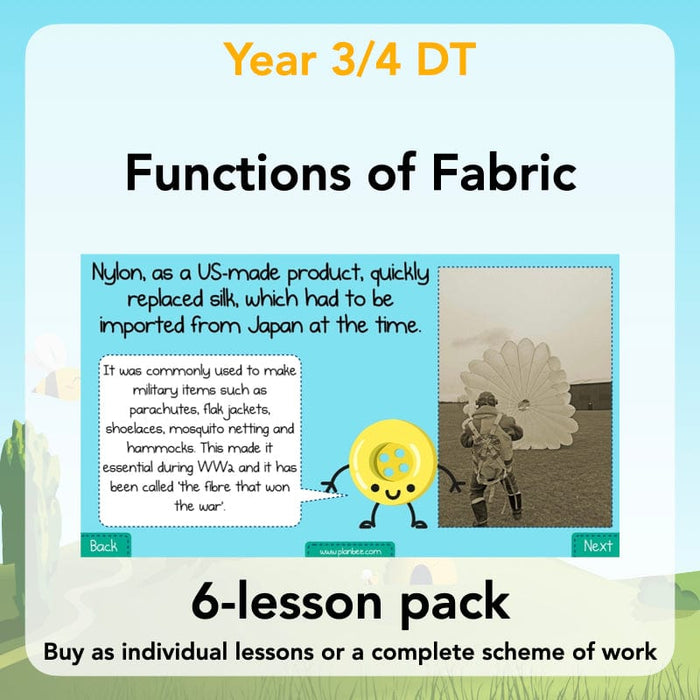

Instantly download six ready-to-teach lessons which will teach your Year 3 and 4 class how to sew. These KS2 textile lessons offer your children the opportunity to discover how fabrics are made, the differences between natural and synthetic fabrics as well as the impact that textile waste and fast fashion is having on our planet.
After learning about the different kinds of fabric your class will use this knowledge to design and make a handy bag or pouch to meet a design brief. Challenge your class to use their learning about different stitches and fastenings to design their own bag using CAD.
These six fully-resourced lessons come with PDF lesson slides and printable resources, a detailed lesson plan as well as differentiated activity ideas for each lesson. Everything you need for a successful textile project.
Properties and Uses of Fabric
In this first lesson, children will find out exactly what a fabric is, and look at some of the common fabrics we use for clothing and soft furnishings.
In their independent activities, children will discuss and answer questions using the provided Fabric Fact Cards, in order to further their knowledge and understanding of different types of fabric. In the alternative activity, children are given the opportunity to practise the art of weaving.
This ready-to-teach Properties and Uses of Fabric lesson includes a detailed plan, an informative slideshow for the teaching input, as well as differentiated, printable resources.
What's included:
- Lesson plan
- Slides
- Activity ideas
- Differentiated worksheets
- Fabric Fact Cards
- Question Cards
- Weaving Instructions Sheet
Natural vs Synthetic Fabrics
Explore the advantages and disadvantages of natural and synthetic fabrics with your class as they discuss the effect that the invention of synthetic fabrics had on fashion and the world. The children will discuss some key events and items of clothing that the invention of nylon had an effect on and what the world might have been like if synthetic fabrics had never been invented.
This lesson comes with PDF lesson slides, lesson plan and printable resources. You'll have everything you need to discover and discuss synthetic fabrics.
What's included:
- Lesson plan
- Slides
- Activity ideas
- Advantages and Disadvantages Cards
- Item Cards
- Natural/Synthetic Fabrics List
Recycling and reusing fabric
In this lesson, children will explore how fabrics can be recycled and reused. They will discover what it means for a fabric to be sustainable as they discover how sustainable different materials are and what they can do to lengthen the life of clothes.
In their independent activities, children will practise their sewing skills so they can mend items of their own clothing. They will sew buttons, repair tears and sew on a patch. In the alternative activity, children are given the opportunity to share their knowledge of reusing and recycling clothes with others.
This downloadable ready-to-teach Properties and Uses of Fabric lesson includes a detailed plan, an informative slideshow for the teaching input, as well as differentiated, printable resources.
What's included:
- Lesson plan
- Slides
- Activity ideas
- How to... cards
- Sewing Stitch Instruction Sheets
- Reuse & Recycle Ideas Sheet
- Leaflet Template
Practising and investigating stitches
Children will begin this lesson by exploring different fabric bags. They will look carefully at the type of stitch used and different types of fastenings, questioning which stitch is the most secure.
Children will then be guided through how to thread a needle before practising different types of stitches. The included printable resources with this lesson contain 'How to' sheets for different stitches for both right and left-handed sewers.
Instantly download a detailed lesson plan, engaging lesson slides and printable resources.
What's included:
- Lesson plan
- Slides
- Activity ideas
- Sewing stitches help sheet
Designing a Fabric Bag
Challenge your class to use what they have learnt about fabrics to design a small fabric bag to meet set criteria. The children will need to think about the kind of fabric they will use, as well as the size that will be needed and the fastenings they would like to use on their bag.
This lesson gives your class the perfect opportunity to create a simple pattern piece using CAD software. They will need to use the software to create a pattern with accurate measurements and symmetrical features for their design.
The resources in this pack include a PDF lesson plan, slides and accompanying printable resources.
What's included:
- Lesson plan
- Slides
- Activity ideas
- Client Design Brief Cards
- Design Sheets
- Teacher Notes
- Challenge Card
Making a Fabric Bag
In this final lesson the children will create their fabric bag using their learning from previous lessons. They will follow their designs and will have the opportunity to evaluate their products against the design criteria in an oral interview with a partner.
This lesson pack comes with everything you need to help guide your class as they create useful fabric bags: detailed lesson plan, lesson slides as well as printable resources.
What's included:
- Lesson plan
- Slides
- Activity ideas
- Sewing stitches sheets
- How to... sheets
- Evaluation interview cards
































































